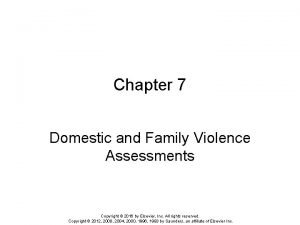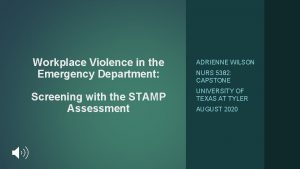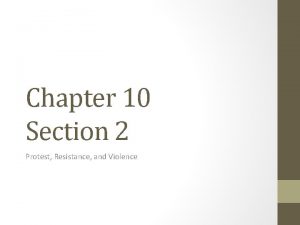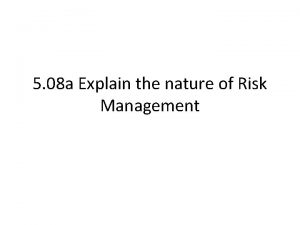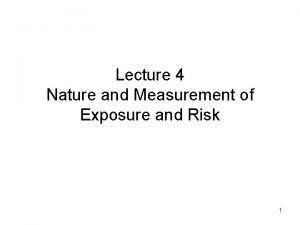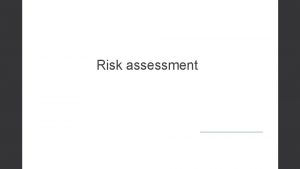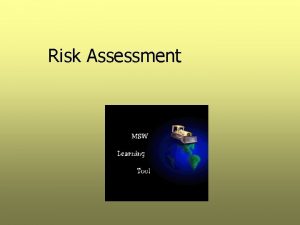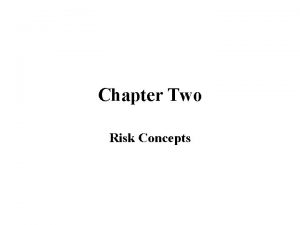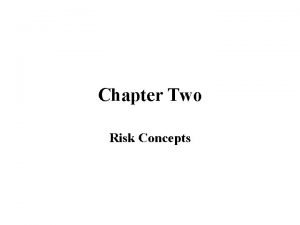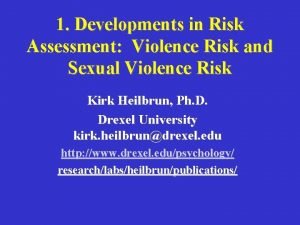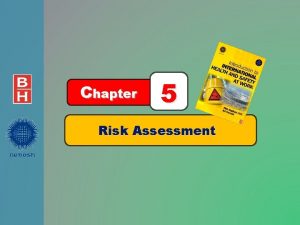Violence Risk Assessment Chapter 5 Nature Violence and















- Slides: 15

Violence Risk Assessment Chapter 5

Nature Violence and Violence Risk Assessment n Defining violence n n Actual, attempted, or threatened physical harm that is deliberate and non consenting Violence as a choice n The proximate cause of violence is a decision to act violently n The decision is influenced by a host of biological, psychological, and social factors n n n Neurological damage, hormonal abnormality Psychosis, personality disorder Exposure to violent models, attitudes that condone violence

We can not predict violence. . . n n Violence is too rare to predict with any accuracy by any means Clinical decisions are particularly poor Mental health experts have no particular expertise in the field of violence Predictions of behavior necessitate a deterministic view of human behavior

. . . or, can we? n n The issue of prediction is moot n Don’t predict, we evaluate risk (e. g. , suicide) Regardless, predictions made by mental health professionals are reliably better than chance The scientific literature on violence is large and growing Any choice can be predicted

Illegal Realities of Violence Risk Assessment n Barefoot v. Estelle (1983) APA amicus curiae brief stated that predictions were unreliable and incorrect n Court ruled testimony admissible and expressed faith in the adversarial process n n n O’Connor v. Donaldson (1975), Addington v. Texas (1979), Schall v. Martin (1984), Kansas v. Hendricks (1997), Kansas v. Crane (2002) Tarasoff v. Regents of the University of California (1976)

The Evolution of Risk Assessment n Early History of Risk Assessment n First Generation – 1970 s n n Second Generation n n Studies were poor in comparison to subsequent generations clinical decision making 50/50 chance (Monahan, 1981) More focus on short-term predictions and psychiatric samples Identification of individual and contextual risk factors Moved from predicting violence to assessing risk Third Generation n marked by the use of actuarial or structured approaches to risk assessment

Clinical, Actuarial, and Structured Risk Assessments n Clinical Predictions n n informal, subjective impressions arrived at with human judgment Actuarial Predictions n n n formal, algorithmic, objective procedures used to arrive at a statistical conclusion n VRAG, ICT, COVR Criticized for lack of generalizability Nomothetic nature (studying groups) compared to the idiographic (studying individuals) nature of risk assessment

Structured Professional Judgments n n n formal but flexible predictions based on the empirical literature n HCR-20, SVR-20 Identifying a list of important risk factors and guidelines for using them Scoring can be similar to actuarial measures, but clinical judgment is encouraged May increases the chance of bias Support for SPJ is promising

Risk and Protective Factors n Static Factors n Historical in nature n variables that are unlikely to change and are often fixed n History of Past violence n Young Age n Psychopathy n Hx Employment Instability n Substance Use n Major Mental Disorder

Dynamic Factors Clinical in nature n variables that are subject to change n n Lack of Insight n Negative Attitudes n Psychiatric Symptoms n Behavioral and Affective Instability n Unresponsiveness to Treatment

Risk Management n Risk Assessment n Reduce likelihood of violence n Identify potential for future violence n Dynamic n Static and dynamic n Post assessment control is high n Post assessment control is variable n Multiple administrations n One administration

Protective Factors n n n protective factors as characteristics or conditions that interact with risk factors to reduce violence offer an explanation for why individuals who face the same degree of risk may be affected differently protective factors do not guarantee that an individual will not become violent. n reduce the probability that people facing a risk factor or factors will become involved in violence

Accuracy of Risk Assessment n Difficulties in Risk Assessment n Difficult to follow-up n Measurement of violence n Definition of violence n Low base rate behavior

When are we good at assessing risk? predictions are for the short-term n environmental settings for which we have past data n high base rates of violence n

Communicating Risk n Risk management n Categorical risk levels n Probability n Frequencies
 Chapter 7 domestic and family violence assessment
Chapter 7 domestic and family violence assessment Market risk credit risk operational risk
Market risk credit risk operational risk Stamp violence assessment tool
Stamp violence assessment tool Chapter 9 lesson 2 resolving conflicts
Chapter 9 lesson 2 resolving conflicts Chapter 27 anger aggression and violence
Chapter 27 anger aggression and violence Chapter 10 section 2 protest resistance and violence
Chapter 10 section 2 protest resistance and violence Chapter 9 resolving conflicts and preventing violence
Chapter 9 resolving conflicts and preventing violence Chapter 10 section 2 protest resistance and violence
Chapter 10 section 2 protest resistance and violence Seceding states of the confederacy
Seceding states of the confederacy Nature and nature's laws lay hid in night meaning
Nature and nature's laws lay hid in night meaning Nature of risk in insurance
Nature of risk in insurance Explain the nature of risk management
Explain the nature of risk management Nature of exposure and risk
Nature of exposure and risk Residual risk and secondary risk pmp
Residual risk and secondary risk pmp Business risk vs financial risk capital structure
Business risk vs financial risk capital structure Relative risk calculation
Relative risk calculation
